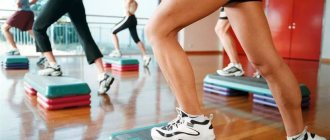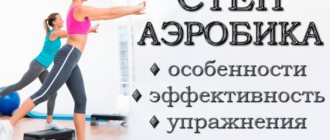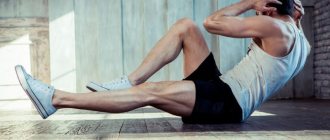Step aerobics is a popular form of fitness that was invented by American trainers in the 80s. The basic principle of such training is descent and ascent when practicing on a special step. With this mechanics of movements, the leg muscles are strengthened and joint mobility is improved. In order not to be unfounded, let's consider the benefits of step aerobics - the impact of training on the body and its effectiveness.
Advantages of step aerobics
Exercise has a number of benefits, one of which is effective fat loss. An hour-long workout at a good pace helps burn up to 500 kcal. The main load falls on the lower part of the body. What muscles are actively working? All parts of the thigh, muscles of the buttocks and lower legs are pumped, which makes the legs slimmer and more prominent.
How else is step aerobics useful, besides the fact that it improves your figure?
- Compared to other types of cardio exercise (running, jumping rope), exercises with a platform cause less damage to joints.
- Aerobics trains the cardiovascular system, increases endurance, and improves coordination.
- Changing the height of the apparatus allows you to individually change the load and degree of difficulty of the workout.
- Jumping is not only effective cardio, but also a good stretch.
- Classes are suitable for effective weight loss at home: for a successful workout you need step, invigorating music and a great mood.
Main conclusions
- The effectiveness of step aerobics for people of all ages becomes obvious after considering its features, as well as its positive effect on the human body.
- Fitness in this area can be useful for both beginners in sports and professionals.
To competently draw up a step aerobics training program, it is necessary to take into account not only the individual characteristics of the human body, but also his endurance, as well as general physical fitness. By regularly performing correctly selected exercises on the steppe, the athlete will be able to achieve the desired result in the shortest possible time.
Contraindications
Despite all the advantages, step aerobics has contraindications. Intense training is risky for those with health limitations:
- diseases of the cardiovascular system;
- diseases of the joints, spine, dysfunction of the musculoskeletal system;
- recent injuries and surgeries;
- severe excess weight;
- hypertension;
- varicose veins of the lower extremities;
- chronic liver diseases;
- pregnancy and the first 3 months after birth.
Features of selecting a step platform
Safe and reliable sports equipment is one of the components of a successful training result. There are several rules for choosing the right platform.
- The step platform must be made of durable plastic and covered on top and bottom with an anti-slip rubberized layer.
- The length should be between 1 and 1.5 meters. Stand on the board and place your feet shoulder-width apart. If you are comfortable and there is no fear of falling from it, the length is chosen correctly.
- The width should be approximately 2 foot lengths (at least 40 cm). You can trip on a narrow platform, and it’s inconvenient to exercise on a wide platform.
- For effective step aerobics, the height of the step is important: the higher, the greater the load. Beginners and short people are advised to choose a low stepper height. It is even better to purchase a model with an adjustment function.
If you can’t buy a projectile in a store, you can make it yourself from wood. A strong wooden or plastic box of the required size will also serve as a platform.
Types of training
Step aerobics is not just boring steps and jumping on a platform. Incendiary music, interesting combinations, dance and strength elements make the classes varied and exciting. Depending on the level of difficulty and techniques used, training is divided into several categories.
- Basic Step - the initial level, where you get acquainted with aerobics, learn basic movements and simple combinations. If you decide to study on platforms, it is better to start from the basic level.
- Advanced Step - a lesson for advanced students, including complex combinations, jumps and turns. The training takes place at an intense pace, the load is higher than the basic one.
- Power Step - power step aerobics. These classes use strength exercises with weights, which allows you not only to lose fat, but also to pump up muscles.
- Step Combo combines dance moves with steps. Fast-paced classes are suitable for trained athletes with good coordination.
- Step Interval - interval training with a change of pace that effectively burns excess fat.
- Dance Step - dance lesson. Emotionally intense workouts improve your mood, develop flexibility and eliminate unnecessary calories.
You can master step aerobics not only in group classes in the gym, but also in your own home environment. Don’t rush to cover all areas at once, start practicing gradually, carefully monitor your well-being. If you experience shortness of breath, dizziness or increased blood pressure during exercise, it is better to slow down.
Do not forget to follow the technique of performing the exercises: movements are carried out due to the work of the leg muscles, the back is straight.
It is especially important: the foot is placed completely on the platform, the heels should not hang over the edge.
What it is
Step aerobics as a fitness trend began to develop in 1989. Initially, such activities were recommended for people with disabilities in sports due to previous injuries. And only around the 2000s, step aerobics experienced a new round of development. Now training of this kind is considered the most effective due to an integrated approach to constructing an algorithm for performing exercises. (1)
Activities of this kind involve the use of a special sports device, a steppe. It is a plastic step, the height of which is adjusted depending on the purpose of the training and the individual characteristics of the person.
Features of this type of fitness
This type of fitness has a number of features that must be taken into account before starting step aerobics classes. These include:
- no need for large financial investments before starting training at home;
- simplicity of basic exercises, which does not require special skills and a high level of physical fitness;
- the ability to strengthen the heart muscle, while pumping muscles and losing weight;
- the presence of several types within the direction, differing from each other in the intensity of the classes, as well as the focus of the exercises themselves included in the complex.
Steps without changing the leading foot
These are basic simple movements, each new beat begins with the supporting leg, no matter how many times you repeat it.
- Basic step - step straight ahead with your leading foot, then the other foot onto the step platform, return with both feet in turn to the floor.
- V-step differs from Basic in that the movements are performed in the corners of the step, i.e. in the “standing on the platform” position, your legs should be placed at opposite ends. Returning to the floor, bring your legs together.
- A-Step is similar to V-step, but the movement begins from the “standing on the step” position: step down twice, put your feet apart, rise back, put your feet together.
- Mambo - step one foot forward onto the board, return the foot back to the floor, and step in place with the other foot.
- Over - a movement with a transition to the other side of the board: approach the step from the side, raise one leg onto the platform, step with the second leg, at the same time turn your back forward and return first the first leg, and then the second to the floor back.
- Straddle includes Straddle Up and Straddle Down. Place the step between your legs, short side forward. For Straddle Up, take the starting position “feet on the floor on opposite sides of the step platform”, then do two climbs onto the board, two descents back to the floor. To perform Straddle Down, take the starting position “standing on the board”, step twice onto the floor on opposite sides, and return.
- Up Up Lunge - rise onto the board with both feet, touch the toes of both feet to the floor twice in turn, and lower to the floor.
Steps with changing leading foot
Exercises with changing the leading leg involve starting each next step with the other leg. You can diversify your workouts with a set of complicated exercises:
- Tap up - step on the opposite edge of the platform with your first foot, place your second foot and touch the step with your toe, and return your feet to the floor one by one. Repeat the exercise on the second leg.
- Knee up is similar to the previous option, but raise the second leg, bent at the knee (turn the thigh parallel to the floor, point the toe down), return to the starting position on the floor.
- Kick - step one foot into the corner of the step, kick with the second straight leg in the air, step back with the same leg and return the first leg to the floor.
- Curl - the movements of the leading leg are similar, raise the second leg in an overlap (point the knee to the floor, reach the buttocks with the heel), go back.
- Lift - rise with your supporting leg to the opposite edge of the platform, swing the second leg straight (front lift), to the side 45 degrees (lift side) or back (Back Lift), descend alternately to the floor;
- L-step - step with the first foot to the other edge of the step, lift the second leg, bent at the knee, and place it on the side of the platform. Shift your body weight, lift your leading leg, bent at the knee, and step back onto the board. Raise the second leg bent at the knee again and return it to its original position, step the leading leg back to the floor.
This is not a complete list of movements, but only the main steps, on the basis of which there are many other elements and connections.
Step aerobics is an interesting type of fitness that really helps you lose weight and get in shape.
Don't be afraid to try, you can start with regular walking. Set a goal, go towards it, and the result will not take long to arrive. The main thing is to listen to yourself, increase the load gradually so that your training brings both joy and benefit. Music for step aerobics
Program options
The step aerobics program should be drawn up depending on the physical fitness of a particular athlete.
For beginners
- Warm up.
- Walking in place – 5 minutes.
- Basic steps – 2 minutes.
- Step accompanied by a kick – 2 minutes.
- High knee step – 2 minutes.
- Step with triple knee lift at one point - 1 minute.
- Step with clap and straight leg swing – 2 minutes.
- Step with leg bending back – 2 minutes.
- Repeat point 7 – 1 minute.
- Step with a swing to the side - 2 minutes.
- Repeat point 7 – 1 minute.
- Stepping onto the steppe with the straight leg moving back – 2 minutes.
- Cool down with restoration of breathing frequency.
For experienced athletes
- Warm up.
- Side step from side to side – 7 minutes.
- Step to the side while simultaneously touching the surface of the step with the opposite foot – 2 minutes.
- Basic steps – 2 minutes.
- Basic diagonal step with clap - 2 minutes.
- Knee step – 3 minutes.
- Repeat point 4 – 2 minutes.
- Double rearrangement of the leg sideways, without lifting it from the surface of the steppe, 4 minutes.
- Repeat step 5 – 2 minutes.
- Crossing the platform sideways with a jump at the top – 4 minutes.
- Repeat step 4 – 2 minutes.
- Crossing the step sideways with knee lift at the top point – 4 minutes.
- Basic walking with a gradual decrease in the tempo of the exercise - 1 minute.
- Cool down with elements of breathing exercises.









